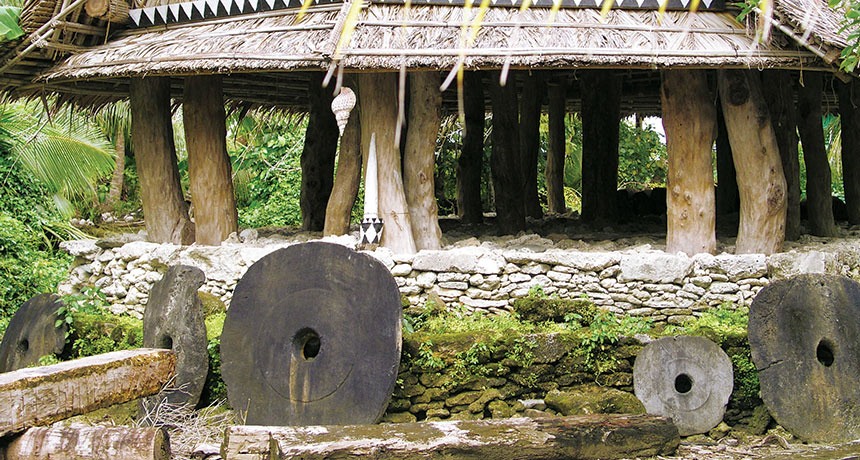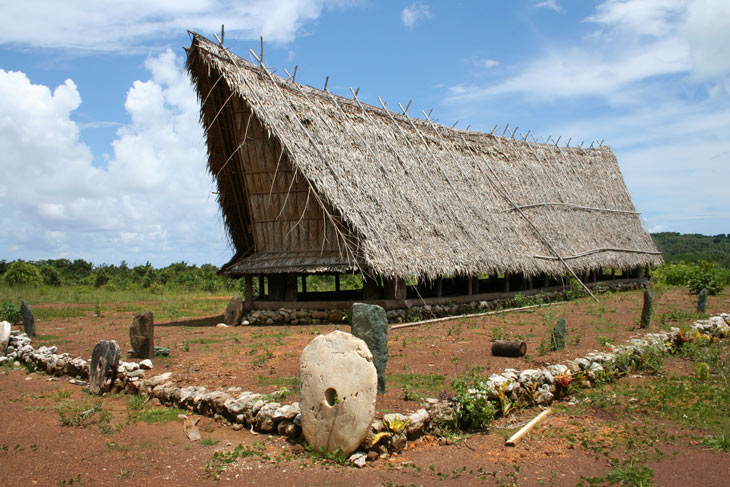How an ancient stone money system works like cryptocurrency
Archaeologists see similarities between giant coins carved from stone and cryptocurrencies

BEEN THERE DONE THAT Yap islanders in Micronesia sailed to nearby islands for limestone to carve into huge disks used as money called rai.
S. Fitzpatrick
Digital currencies, such as Bitcoin, and the blockchain technologies used to record digital transactions on a public ledger may not be so revolutionary.
At least several hundred years ago, islanders on Yap in western Micronesia used principles at the heart of cryptocurrencies to conduct business, says archaeologist Scott Fitzpatrick of the University of Oregon in Eugene.
“Stone money transactions on Yap were the precursor to Bitcoin and blockchain technologies,” Fitzpatrick says. At April’s annual meeting of the Society for American Archaeology in Washington, D.C., he explained the connection between the carved stone disks, some weighing more than a Honda Accord and standing taller than a man, and today’s cyber-tokens floating in digital space.
Based on studies of rock sources and dating of sites on Yap and nearby islands, Fitzpatrick thinks that, before European contact in 1783, inhabitants of Yap sailed about 400 kilometers to other islands in Micronesia to quarry limestone from caves and rock-shelters. Sea voyagers negotiated with local leaders for access to limestone deposits.

Stone carvers went along for the ride and formed stone disks on site. A central hole was cut into each circular chunk of rock so men could run a wooden pole through the opening to hoist the rock. These weighty pieces of currency, called rai, were transported to Yap on rafts.
Arriving back home, travelers presented newly acquired rai to their fellow community members at a public gathering. Everyone heard which individuals or clan groups took ownership of particular disks. Each rai was assigned a value based on size, evenness of shape, stone quality and risks taken on the journey. After being inspected and verified by a local chief, rai were displayed at communal spots, such as ritual dancing grounds.
Ownership of a disk could be transferred, for instance, as a wedding gift, to secure political allies or in exchange for food from residents of nearby islands after a severe storm. These deals also occurred in front of the whole community. No matter who acquired a rai, it stayed in its original location.
Bitcoin and blockchain work in much the same way, Fitzpatrick says. Bitcoin “miners” solve complex mathematical puzzles to release units of currency. Those units are transported and securely stored across the public blockchain ledger. Full transaction histories for each bitcoin are available to all network participants. Bitcoins can be exchanged for goods or services or given away at any time by participants in the digital system.
A comparison of stone money on Yap to blockchain technology “is legitimate,” says anthropological archaeologist Kathryn Sampeck of Illinois State University in Normal. Yap islanders pioneered a public, oral system for securely tracking and exchanging rai. Blockchain does the same by maintaining digital histories and updates about units of cryptocurrency.
Others disagree. Researchers such as anthropologist David Graeber of the London School of Economics and Political Science, who view money as the product of government taxation and debt, don’t think Yap disks qualify as currency. For instance, rai can’t be divided into smaller parts to make purchases or easily carried from place to place.
Digital currencies don’t live up to their name either, the same group argues. Bitcoin and its cousins are unregulated exchange units with wildly fluctuating values. That makes these digital creations unlikely to catch on among consumers and tax collectors, critics predict.
The fate of cryptocurrencies is, for now, cryptic. “Not a whole lot of people buy stuff with Bitcoin and the concept of cryptocurrencies is very abstract,” says anthropological archaeologist Joanne Baron of Bard High School Early College in Newark, N.J. Stone money’s future on Yap is also up in the air, Fitzpatrick says. Although rarely exchanged for anything these days and often abandoned in the jungle, rai are now being rescued and renovated by islanders interested in their past.







